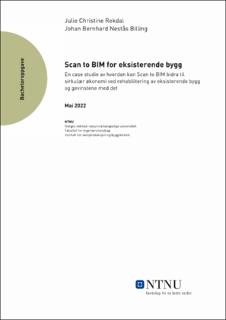| dc.contributor.advisor | Huang, Lizhen | |
| dc.contributor.author | Rekdal, Julie Christine | |
| dc.contributor.author | Billing, Johan Bernhard Nestås | |
| dc.date.accessioned | 2022-07-23T17:19:40Z | |
| dc.date.available | 2022-07-23T17:19:40Z | |
| dc.date.issued | 2022 | |
| dc.identifier | no.ntnu:inspera:106257797:112680673 | |
| dc.identifier.uri | https://hdl.handle.net/11250/3007988 | |
| dc.description.abstract | Siden byggebransjen står for 40% av det samlede energiforbruket og 40% av materialforbruket, har bransjen et ansvar til å redusere forbruket. Denne bachelor oppgaven er laget for å støtte overgangen fra lineær økonomi til sirkulær økonomi, under det grønne skiftet-sirkTRE er finansiert av Norges forskningsråd. «sirkTRE» har som mål å løfte byggenæring og treindustrien i retningen det grønne skiftet ved å sørge for at returtre gjenbrukes i byggeprosjekter.
Oppgaven handler om, hvordan man kan 3D-modellere et eldre eksisterende tre bygg ved hjelp av Scan to BIM, for å hente ut informasjon om materialmengder. Denne informasjonen kan knyttes opp mot tanken om å kunne gjenbruke materialene og ha en oversikt over hvor mye av materialene som er tilgjengelig til gjenbruk.
Denne oppgaven har som mål å besvare følgende problemstilling:
Hvordan kan Scan to BIM bidra til sirkularitet av eksisterende bygg: case av låver i Norge?
For å svare på problemstillingen har vi laget 3D-modeller av tre låver, som visualiserer et forslag på ferdige bygg modellert fra punktsky data. Videre svarer vi på hvordan BIM er brukbart i rehabilitering prosesser og hvordan det kan hjelpe ved gjenbruk og resirkulering av materialer og rivnings avfall.
Som resultat av oppgaven vises ferdig 3D-modell, planløsning, samt materialmengden som ble hentet ut av 3D-modellene av låvene. Resultatene fra skanningene og modelleringen skal være tilgjengelig for fremtidig bruk av andre om det skulle være ønskelig å utvikle modellene mer detaljert.
Endelig konklusjon er at Scan to BIM fungerer godt ved visualisering og mengdeberegning av eksisterende bygg, men trenger ytterliggere informasjon for å kunne bli brukt for å finne ut av hvilke materialer som kan bli gjenbrukt. I tillegg, kommer det frem at målet med prosjektet sirkTRE, er fullt mulig å gjennomføre, men det må bli satt begrensinger med tanke på hva slags deler av konstruksjoner som kan bli gjenbrukt. Potensialet til prosjektet er avhengig av kvaliteten til trevirke, og kostnadene som er knyttet med redokumentasjon av bygningselementer ved gjenbruk. | |
| dc.description.abstract | Since the construction industry accounts for 40% of the total energy consumption and 40% of the material consumption, has the industry a responsibility to reduce consumption. This bachelor thesis is created to support the transition from linear economics to circular economics, under Green Platform-sirkTRE financed by Norwegian research council. "sirkTRE" aim to lift the construction industry and the wood industry in the direction of the green transition by ensuring that recycled wood is reused in construction projects.
This thesis focuses on, how to make 3D-models of older existing wooden buildings with the help of Scan to BIM, to collect information about quantities of materials. This information can be linked up to the thought of the possibility to reuse the materials and get an overview over how much of the materials that are available for reuse.
This thesis aims to answer the following research question:
How can Scan to BIM contribute to the circularity of existing buildings: case of barn in Norway?
To answer the research question, we have made 3D-models of three barns, to visualize a suggestion on finalized buildings, through the point cloud data. Further, we discuss how BIM can be used in the rehabilitation processes, as well how this can help with reuse and recycling of materials and waste related to demolition.
As a result of the assignment, the finished 3D model, floor plan, as well as the amount of material that was extracted from the 3D models of the barns are shown. The results from the scans and modelling are available for future use by others if it should be desirable to develop the models in more detail.
The conclusion is that Scan to BIM works well when visualizing and quantifying existing buildings but needs additional information to be able to be used to find out which materials can be reused. In addition, the goal of the project sirkTRE is possible to implement, but restrictions must be set with regard to what kind of parts of constructions can be reused. The potential of the project depends on the quality of the wood, and the costs associated with the documentation of building elements through reuse. | |
| dc.language | nob | |
| dc.publisher | NTNU | |
| dc.title | Scan to BIM for eksisterende bygg | |
| dc.type | Bachelor thesis | |
